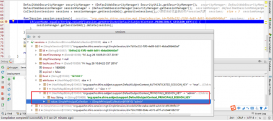因為看StringBuffer 和 StringBuilder 的源碼時發現兩者都繼承了AbstractStringBuilder,并且很多方法都是直接super的父類AbstractStringBuilder的方法,所以還是決定先看AbstractStringBuilder的源碼,然后再看StringBuffer 和 StringBuilder.
位置:java.lang包中
聲明: abstract class AbstractStringBuilderimplements Appendable, CharSequence
AbstractStringBuilder 類有abstract 修飾,可知它不能被實例化。
AbstractStringBuilder 類有兩個子類:StringBuilder和StringBuffer。
字段
|
1
2
3
4
5
6
7
8
|
/** * The value is used for character storage. */ char value[]; /** * The count is the number of characters used. */ int count; |
構造器
1、無參構造器
|
1
2
|
AbstractStringBuilder() { } |
2、創建abstractstringbuilder實現類的對象時指定緩沖區大小為capacity。
|
1
2
3
|
AbstractStringBuilder(int capacity) { value = new char[capacity]; } |
當子類StringBuilder或StringBuffer實例化時,會在構造器中調用此構造器。
擴充容量
void expandCapacity(int minimumCapacity)
此方法有包訪問權限,類中有多個方法會調用此方法,在容量不足時擴充容量。
源碼:
|
1
2
3
4
5
6
7
8
9
|
void expandCapacity(int minimumCapacity) { int newCapacity = (value.length + 1) * 2; if (newCapacity < 0) { newCapacity = Integer.MAX_VALUE; } else if (minimumCapacity > newCapacity) { newCapacity = minimumCapacity; } value = Arrays.copyOf(value, newCapacity); } |
將緩沖區長度加1乘2的值賦予變量newCapacity, 然后將此值與指定的值比較,將較大值確定為緩沖區的新容量;然后調用Arrays類的copyof方法,此方法會創建一個新數組,然后將原數組中的字符全部復制進新數組中。
ensureCapacity(int minimumCapacity)
|
1
|
public void ensureCapacity(int minimumCapacity) |
確保容量至少等于指定的最小值。如果當前容量小于指定值,則創建新數組,新數組的容量為指定值的兩倍加2;如果當前容量不小于指定值,則直接不做處理。
源碼:
|
1
2
3
4
5
|
public void ensureCapacity(int minimumCapacity) { if (minimumCapacity > value.length) { expandCapacity(minimumCapacity); } } |
測試:
|
1
2
3
4
5
6
7
8
|
StringBuffer s = new StringBuffer();System.out.println("容量:" + s.capacity());// 容量:16s.ensureCapacity(10);System.out.println("容量:" + s.capacity());// 容量:16s.ensureCapacity(30);System.out.println("容量:" + s.capacity());// 容量:34s.ensureCapacity(80);System.out.println("容量:" + s.capacity());// 容量:80 |
方法
codePointAt方法中都是用Character.codePointAtImpl(value, index, count)來實現的
|
1
2
3
4
5
6
|
public int codePointAt(int index) { if ((index < 0) || (index >= count)) { throw new StringIndexOutOfBoundsException(index); } return Character.codePointAtImpl(value, index, count); } |
getChars方法的實現用的是System.arraycopy()方法
|
1
2
3
4
5
6
7
8
9
10
|
public void getChars(int srcBegin, int srcEnd, char[] dst, int dstBegin) { if (srcBegin < 0) throw new StringIndexOutOfBoundsException(srcBegin); if ((srcEnd < 0) || (srcEnd > count)) throw new StringIndexOutOfBoundsException(srcEnd); if (srcBegin > srcEnd) throw new StringIndexOutOfBoundsException("srcBegin > srcEnd"); System.arraycopy(value, srcBegin, dst, dstBegin, srcEnd - srcBegin); } |
append方法都牽扯到了ensureCapacityInternal()方法和getChars()方法來實現
|
1
2
3
4
5
6
7
8
9
|
public AbstractStringBuilder append(String str) { if (str == null) return appendNull(); int len = str.length(); ensureCapacityInternal(count + len); str.getChars(0, len, value, count); count += len; return this; } |
使用了Arrays.copyOf()來實現
|
1
2
3
4
5
6
7
8
9
10
11
|
void expandCapacity(int minimumCapacity) { int newCapacity = value.length * 2 + 2; if (newCapacity - minimumCapacity < 0) newCapacity = minimumCapacity; if (newCapacity < 0) { if (minimumCapacity < 0) // overflow throw new OutOfMemoryError(); newCapacity = Integer.MAX_VALUE; } value = Arrays.copyOf(value, newCapacity); } |
Arrays.fill(value, count, newLength, ‘\0');字符串之間的復制
|
1
2
3
4
5
6
7
8
9
10
11
|
public void setLength(int newLength) { if (newLength < 0) throw new StringIndexOutOfBoundsException(newLength); ensureCapacityInternal(newLength); if (count < newLength) { Arrays.fill(value, count, newLength, '\0'); } count = newLength; } |
delete() 僅改變字符串的大小并未真正的刪除字符串
|
1
2
3
4
5
6
7
8
9
10
11
12
13
14
|
public AbstractStringBuilder delete(int start, int end) { if (start < 0) throw new StringIndexOutOfBoundsException(start); if (end > count) end = count; if (start > end) throw new StringIndexOutOfBoundsException(); int len = end - start; if (len > 0) { System.arraycopy(value, start+len, value, start, count-end); count -= len; } return this; } |
學會靈活的運用System.arraycopy()方法
|
1
2
3
4
5
6
7
8
9
10
11
12
13
14
15
|
public AbstractStringBuilder insert(int index, char[] str, int offset, int len) { if ((index < 0) || (index > length())) throw new StringIndexOutOfBoundsException(index); if ((offset < 0) || (len < 0) || (offset > str.length - len)) throw new StringIndexOutOfBoundsException( "offset " + offset + ", len " + len + ", str.length " + str.length); ensureCapacityInternal(count + len); System.arraycopy(value, index, value, index + len, count - index); System.arraycopy(str, offset, value, index, len); count += len; return this; } |
總結
以上就是本文關于源碼詳細解讀AbstractStringBuilder類源碼詳細解讀的全部內容,希望對大家有所幫助。感興趣的朋友可以繼續參閱本站其他相關專題,如有不足之處,歡迎留言指出。感謝朋友們對本站的支持!
原文鏈接:http://blog.csdn.net/freedom_wei/article/details/50345645














